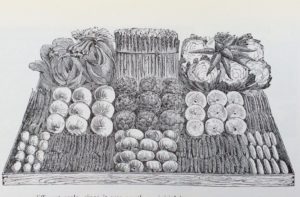FEBRUARY GARDEN CALENDAR

GARDEN SEED
RACKS
ARE IN
OUR STORE
NOW!
We have 3 racks:
FERRY MORSE Certified Organic Seeds
TRIPLE DIVIDE Montana-grown Certified Organic Seeds
And
Baker Seeds’
HEIRLOOM NATIVE AMERICAN Vegetable and Flower Seeds
FEBRUARY GARDENING CALENDAR
February is a winter month for us and usually not much can be done outside besides shoveling snow. But seed catalogs are still arriving and seed racks are in stores and garden centers now, so we can plan the garden. It is a good time to order new bare root plants for spring delivery (such as most perennials, roses, etc.). Later, in the spring, potted plants will be available in local nurseries.
If you have hotbeds (heated frames) you can sow several kinds of seed directly into the soil: arugula, carrots, celery, corn salad, fava beans, cress, mustard and turnip greens, onions, peas, radishes and spinach. Inside, under lights, you can sow eggplant, onions and peppers to be grown on and transplanted out later. It might be better to wait to start tomatoes unless you have a good light system or greenhouse, because the plants will get “leggy” reaching for light inside during our short winter days. Some slow-growing flowers can be started inside now under lights, including: petunias, impatiens, lobelia, pansies, salvias, and perennial herbs and flowers. (Cover pansy seeds well as they need darkness to germinate). Check and ventilate cold frames and keep them covered at night.
Continue forcing flowers in the greenhouse, such as tulips, narcissus, roses and lily of the valley. Strawberries can be forced now in the greenhouse also. Protect alpines, auriculas and other primroses in pots (in a cold greenhouse) from too much rain or frosts as they will begin to bud. Pick off dead leaves, remove the top of the soil off of the pot and replace it with rich compost. After adding compost, clean the outside of the flower pots with warm soapy water. Only a little water may be given to the plants, but give plentiful air. Sow any remaining alpine, wildflower, primula and auricula seeds.
Late in the month, if weather permits, sow hardy annuals outside: cornflowers, alyssum (Lobularia maritima) larkspur, sweet peas, Lychnis, Nigella, Lavatera, poppies, kiss-me-by-the-garden-gate, dill and wildflowers. If the snow is gone you can begin planting and/or pruning fruit trees: peaches, plums, cherries, nectarines, apples, medlars, quinces and pears. Plant and/or prune: gooseberries, currants and raspberries. Manure and other organics can be spread outside over vegetable beds, if this was not already done in December. Prune and manure grapes, leaving space around the stems. Grapes can be grafted late in the month.
In late February you can sow stone fruit seeds for rootstocks and hawthorn seeds for hedges; later transplanting them to their permanent position (after three years).
Late in the month is a good time to begin planting and dividing perennials (if the snow is gone and the ground thawed). Also, if weather permits, propagate roses and other shrubs by suckers, layering and cuttings.
